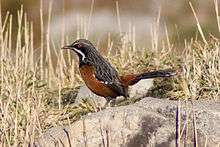Rockjumper
The rockjumpers are medium-sized insectivorous or omnivorous birds in the genus Chaetops, which constitutes the entire family Chaetopidae. The two species, the Cape rockjumper, Chaetops frenatus, and the Drakensberg rockjumper, Chaetops aurantius, are endemic residents of southern Africa.[1] The Cape rockjumper is a resident of the West Cape and south-west East Cape, and the orange-breasted (or Drakensberg) rockjumper is distributed in the Lesotho Highlands and areas surrounding them in South Africa. The two rockjumpers have been treated as separate species but differ in size and plumage. The ranges do not overlap, but come close to doing so.
| Rockjumpers | |
|---|---|
 | |
| Cape rockjumper (Chaetops frenatus) | |
| Scientific classification | |
| Kingdom: | Animalia |
| Phylum: | Chordata |
| Class: | Aves |
| Order: | Passeriformes |
| Family: | Chaetopidae Fjeldsa, Ericson, Johannson, & Zuccon, 2015 |
| Genus: | Chaetops Swainson, 1832 |
| Species | |
|
Chaetops frenatus | |
Taxonomy and systematics
Originally, these birds were placed in the thrushes, and they have also been placed with the Old World warblers and the babblers, but recent DNA studies indicate these birds are actually members of a basal group of oscines within the infraorder Passeri along with their sister-family the rockfowl (Picatharthidae), [2]
Some authorities (notably Dickinson and Christidis) treat the two rockjumpers as a single species, Chaetops frenatus, with two subspecies.[3] Their latin names derive from descriptions of their appearance. "Frenatus" refers to the "bridled" or black-and-white head pattern, while "Aurantius" refers to the orange coloration.
Description
These are small birds with mostly black, white, and red plumage. Both species have long, white tipped black tails, black throats, broad white submoustachial lines and eyebrows, rufous or orange bellies and rumps, and grey and black patterned backs and wings. Females have similar pattern to males, but duller.[1] The iris is red and the bills and legs are black. Their wings are very small and they do not fly very often. They spend most of their lives running and jumping among rocks and grasses while hunting insects.
Behaviour and ecology
Diet and feeding
The rockjumpers feed in groups, foraging on the ground. The groups can number up to 6 birds (for Cape) and 12 birds (for Drakensberg), but the groups may also spread out quite widely during feeding.[4][5] Insects are the major part of the diet, although small vertebrates are reported to be taken by Cape rockjumpers.[4] A range of insects are taken, including caterpillars, moths, grasshoppers, beetles and flies. In addition to insects other prey include lizards and geckos, amphibians, scorpions, annelid worms and spiders.
Breeding
They are monogamous and pairs establish territories which are defended year round. In the Cape rockjumper the territories vary in size from 4–11 ha (10–27 acres). Both species employ helpers, usually the young of previous broods, to aid the breeding pair in raising the young.[6] Nests are built out of grass on the ground (in contrast to rockfowl, which build mud nests in colonies).[7] The clutch size is two eggs for the Cape and two to three eggs for the Drakensberg.[1] Both sexes incubate the clutch for 19–21 days. Chicks fledge at 19–21 days, although they are fed by the parents and helpers for up to 4 weeks following fledge.
References
- del Hoyo, J.; Elliot, A. & Christie D. (editors). (2007). Handbook of the Birds of the World. Volume 12: Picathartes to Tits and Chickadees. Lynx Edicions. ISBN 978-84-96553-42-2
- Oliveros et al. 2019
- Lepage, Denis. "Chaetops [frenatus or aurantius] (Rock Jumper) - Avibase". avibase.bsc-eoc.org. Retrieved 9 September 2017.
- Collar, N., Robson, C. & Sharpe, C.J. (2017). Cape Rockjumper (Chaetops frenatus). In: del Hoyo, J., Elliott, A., Sargatal, J., Christie, D.A. & de Juana, E. (eds.). Handbook of the Birds of the World Alive. Lynx Edicions, Barcelona. (retrieved from http://www.hbw.com/node/59691 on 4 July 2017).
- Collar, N. & Robson, C. (2017). Drakensberg Rockjumper (Chaetops aurantius). In: del Hoyo, J., Elliott, A., Sargatal, J., Christie, D.A. & de Juana, E. (eds.). Handbook of the Birds of the World Alive. Lynx Edicions, Barcelona. (retrieved from http://www.hbw.com/node/59692 on 4 July 2017).
- Holmes R, Frauenknecht B, & M Du Plessis (2002) "Breeding System of the Cape Rockjumper, a South African Fynbos Endemic" Condor 104 (1): 188–192 doi:10.1650/0010-5422(2002)104[0188:BSOTCR]2.0.CO;2
- Thompson, Hazell S. (2003). "Rockjumpers and Rockfowl". In Christopher Perrins (ed.). Firefly Encyclopedia of Birds. Firefly Books. pp. 515. ISBN 1-55297-777-3.